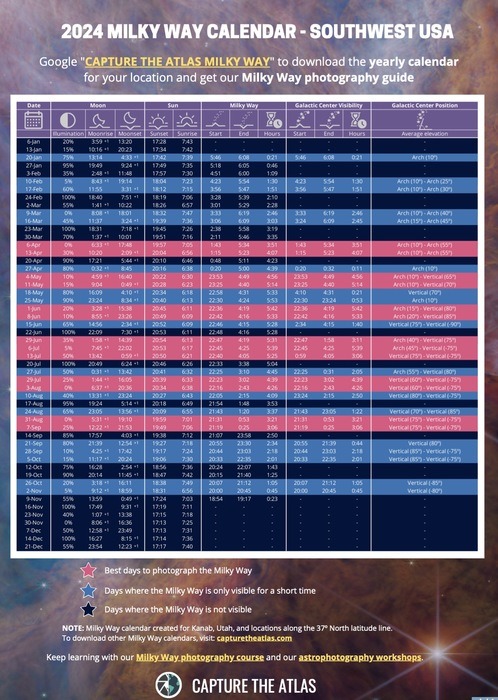THE 25 MOST INSPIRING MILKY WAY PICTURES
Photographing the Milky Way is one of the most challenging but rewarding experiences.
It requires great planning, and there are always a few technical things to consider. However, seeing the galaxy captured on the screen of your camera is an excitement that is difficult to describe.
Any great Milky Way photograph always goes beyond technical steps; there is a moment, a story, and a seed that has been growing in the photographer’s mind for some time until all the elements align to create the image.
To help you find inspiration for planning and executing your Milky Way shots, we’ve gathered the best Milky Way images taken around the world, as we do every year. Buckle up because this trip is going to take you from the far American Wild West to the unfamiliar landscapes of Antarctica, passing by spectacular deserts, glaciers, mountains, beaches…always with the Milky Way shining in the sky.
“Winter Milky Way” – Dr. Nicholas Roemmelt
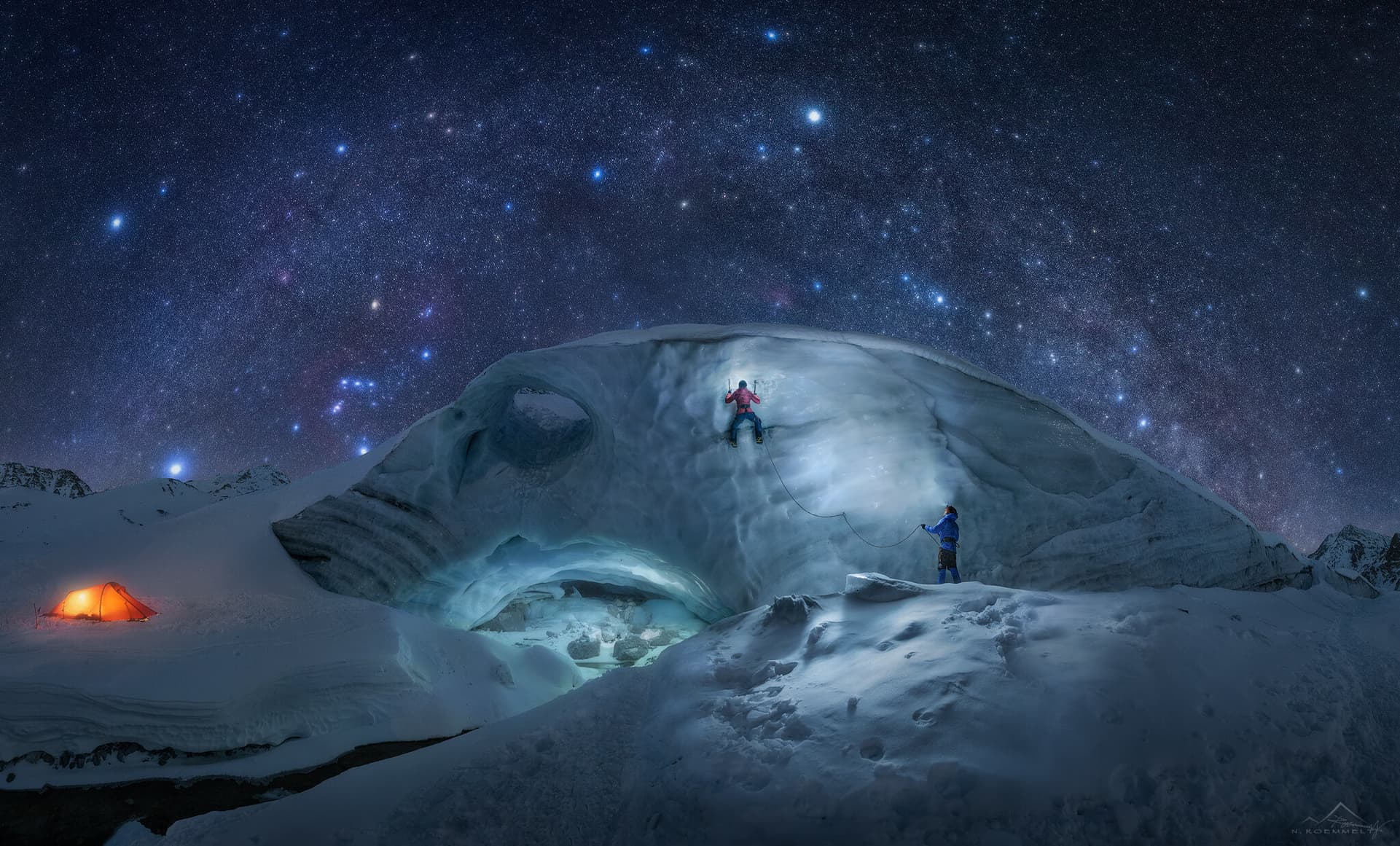
“Winter Milky Way” – Dr. Nicholas Roemmelt
- Marmolada, Dolomites – Italy
This climbing route is located on the south face of the Marmolada, the “Queen of the Dolomites.“ When I saw this glacial gate, it instantly reminded me of a gigantic shark, and I wanted to take this image as a tribute to Hansjörg Auer, one the best climbers of our time, who unfortunately passed away in an avalanche while climbing the Canadian Mountain Howse Peak (together with David Lama and Jess Roskelley) last year.
Our really short pitch in the ice of the glacier was of course not as difficult at all, but I couldn’t help but think of climbing that compact and overhanging ice shield under the winter Milky Way.
Although the Milky Way during the winter and early spring is often ignored in Astro-landscape photography, I really love the bright stars (some of the brightest of the night sky), colorful constellations, and fainter elements of this part of our galaxy when the galactic core is beneath the horizon.
Canon EOS 6Da
Canon EF 16-35mm f2.8 L III @16mm
2 row panorama 6 positions each row.
Upper row, stars
6X single shot, tracked, Tiffen Double Fog Filter
f4.0, 60s, Iso 6400
Lower row, foreground
6X f2.8, 15s, Iso 6400 (per position)
Exposure bracketing
f2.8, 15s, Iso 6400 -> 5s ->2s ->1s (for the positions with tent, hiker)
Blending of exposure bracketing and tracked/untracked pictures in PS -> stitching of the 6X2 master files in PTGUi Pro and cropping + final processing in PS.
“Lake Rotoiti by night” – Mark Gee

“Lake Rotoiti by Night” – Mark Gee
- Nelson Lakes National Park – New Zealand
This image was shot at Lake Rotoiti, which is part of the Nelson Lakes National Park on the South Island. I had headed down there to visit a friend who’s right into astronomy, and he took me to this location. We were the only ones there that night, miles away from any real population. The Milky Way was absolutely stunning above the snow-capped mountains. I only wished it wasn’t so windy, so I could capture a better reflection in the lake, but regardless, it was another amazing night under the New Zealand night sky.
I’ve travelled all over the world photographing the night sky, but I have to say my favorite country to shoot is still at home in New Zealand. We’re very lucky here to have a relatively small population and lots of rural areas with very little light pollution overall, not to mention the stunning landscapes in these locations, from towering snow-capped mountain ranges to rugged beaches and subtropical rainforests. New Zealand is a stunning place to photograph the night sky, and I haven’t come across another place like it.
“Milky Way over Parque Nacional del Teide” – Mehmet Ergün

“Milky Way over Parque Nacional del Teide” – Mehmet Ergün
- Tenerife – Spain
This photo was taken on one of my favorite islands: Tenerife. This is an island with unlimited possibilities, where you can enjoy nature in all its glory. In particular, the night sky over Tenerife is renowned worldwide for its excellent conditions for stargazing and astrophotography.
In Teide National Park, every corner is different and beautiful, I just love it!
Equipment:
Nikon D850 Astro (CentralDS)
Samyang 24mm f1.4
Fornax Lightrack II
“Antennas of ALMA” – Yuri Beletsky

“Antennas of ALMA” – Yuri Beletsky
- Llano de Chajnantor Observatory – Chile
ALMA (Atacama Large Millimeter/submillimeter Array) is the world’s largest ground-based facility for observations and is located on the Chajnantor plateau at an altitude of 5,000 meters (~16000 feet) altitude in northern Chile.
The sky is extremely clear over there, yet the place is extremely harsh for astro photographers. Lack of oxygen, low temperatures (down to -30Cº or so), and fierce winds all make your presence at night at such an altitude very uncomfortable. The site is closed to the general public, with only pre-authorized visits allowed.
We spent a few nights at this high site, and every morning, we had to go down to the basecamp (located at ~3,000m) to get some rest and sleep. The view of the Milky Way is quite spectacular; and it’s easy to feel like you’re in a space station. However, taking images at such an altitude isn’t easy; to prevent the effects of severe hypoxia and stay focused, we had to use supplementary oxygen. Also, you have to move around quite slowly to preserve energy. One of the unique features of the geographical location of this site is that the brightest part of the Milky Way (Galactic Bulge) basically culminates at the zenith, which provides an absolutely amazing view of the whole night sky.
This particular image is a panorama taken with a Nikon D810a camera (designed specifically for astrophotography) and a Sigma 15/2.8 fisheye lens. I took exposures up to 30 sec to capture most of the details of the Milky Way, and used Adobe Photoshop CC for image processing and final color correction. The green color cast (just above the horizon) is due to the so-called “airglow”.
“Deadvlei” – Stefan Liebermann
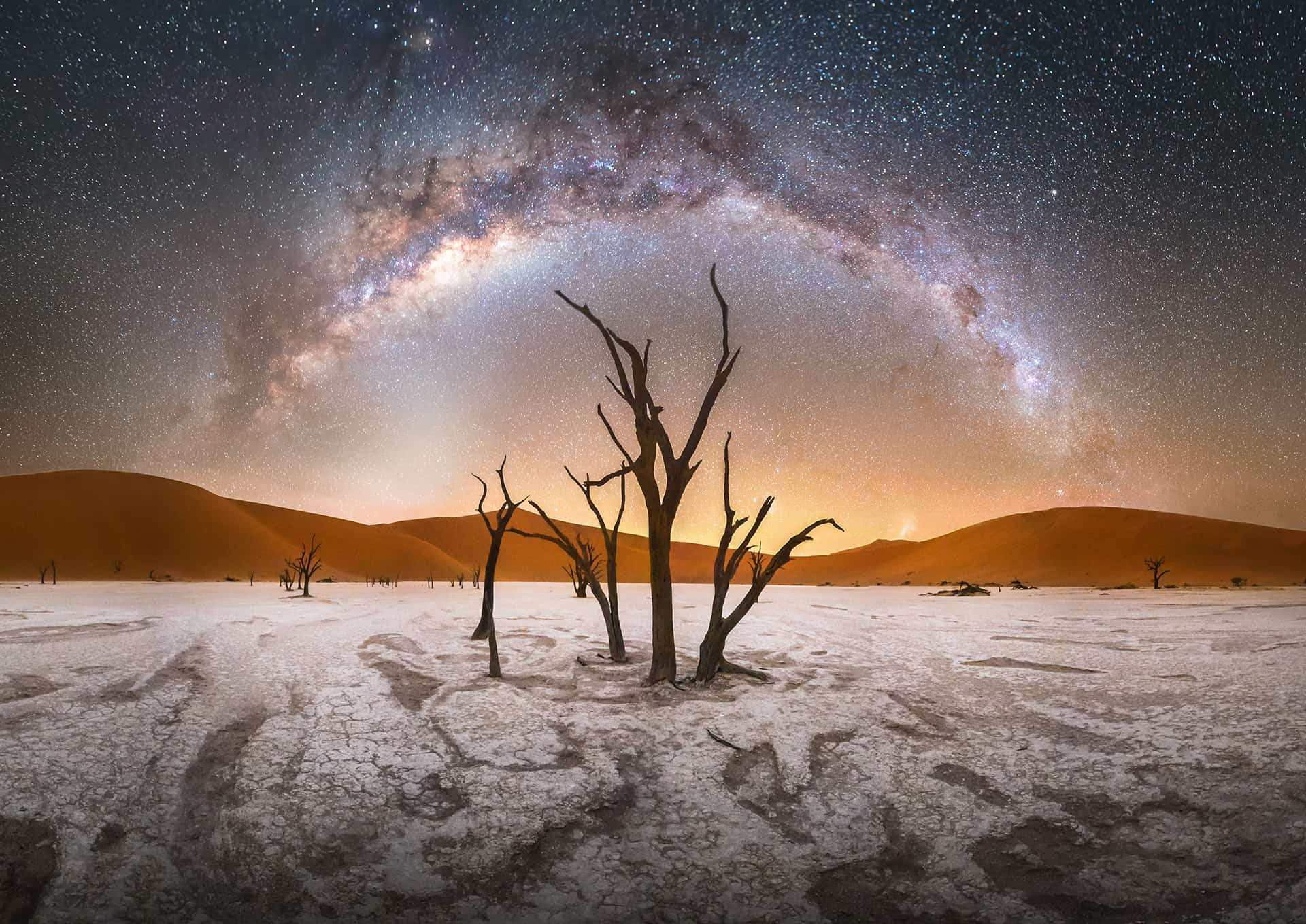
“Deadvlei” – Stefan Liebermann
- Namib-Naukluft National Park – Namibia
The trees in Deadvlei have been dead for over 500 years. Located in Namib-Naukluft Park in Namibia, these saplings grew after local rivers flooded because of severe rainfalls, but died after the sand dunes shifted to section off the river.
High above and far in the distance, the band of our Milky Way galaxy forms an arch over a large stalk in this night panorama image. The soil of white clay appears to glow, reflected by the starlight. Rising on the left and, under the Milky Way’s arch, is a band of zodiacal light — sunlight reflected by dust orbiting in the inner solar system. On the right, just above one of Earth’s larger sand dunes, an astute eye can find the Large Magellanic Cloud, a satellite galaxy of our Milky Way galaxy.
“Madeira Stars” – Daniel Kordan
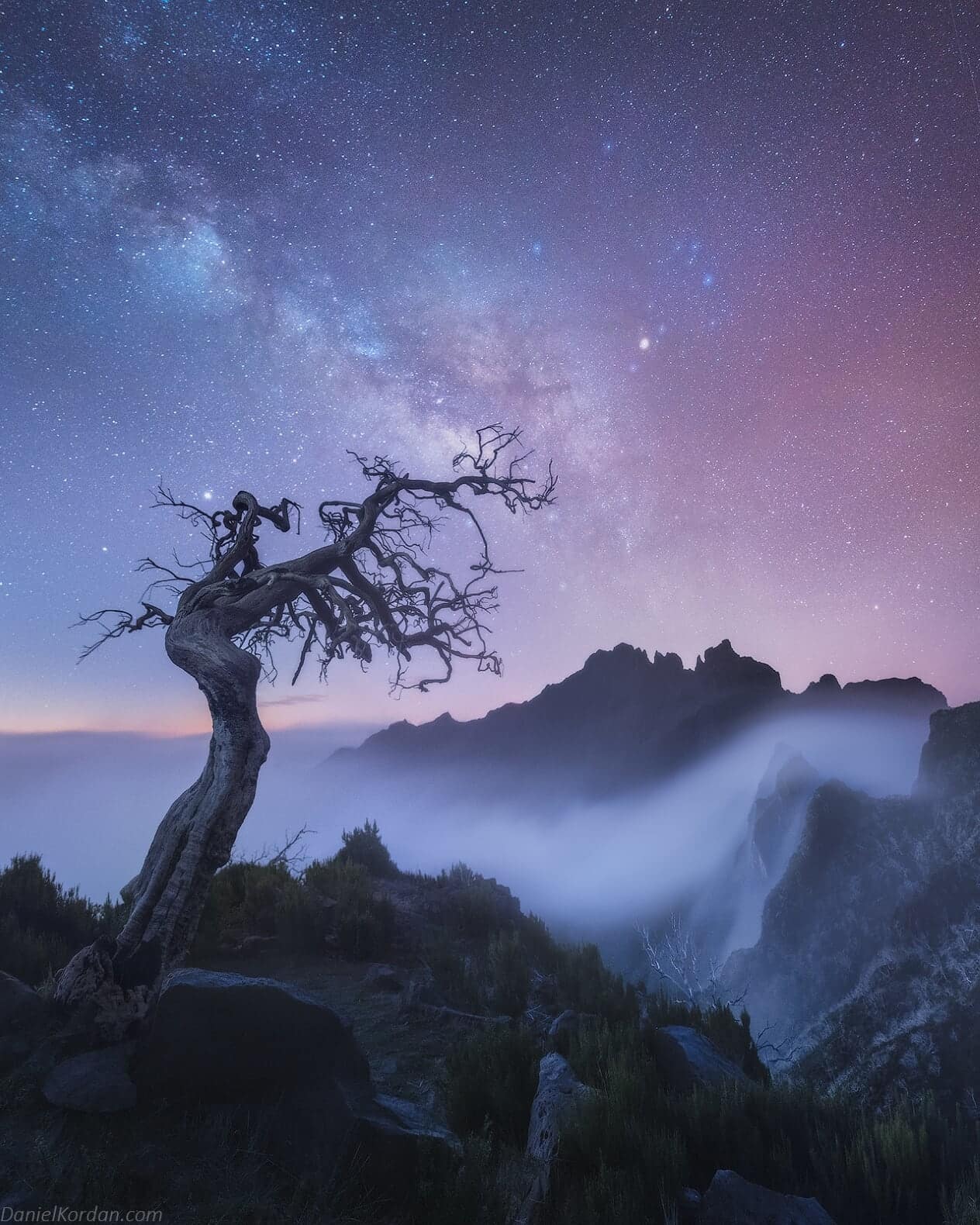
“Madeira Stars” – Daniel Kordan
- Madeira Island – Portugal
During my last trip to Madeira, I hiked under billions of stars and over an ocean of clouds. It sounds like a fairy tale, but Madeira is a magical island that offers these opportunities.
This night, I shot the Milky Way just an hour before sunrise from one of the high Madeira peaks. In the background there was a “cloudfall,” a phenomenon that takes place in some Atlantic islands where clouds fall in a cascade from one valley to another like a waterfall.
The image is a Vertical panorama of 2 horizontal shots made with 14-24 mm nikkor, 20 s each at iso 4000, f/2.8 + blue hour exposure for foreground at f/5 iso 400, 70 s.
“Nightmare” – Michael Goh

“Nightmare” – Michael Goh
- Dumbleyung Lake – Australia
Dumbleyung Lake is a salt lake located in western Australia. The lake is surrounded by hundreds of trees that have died due to the salt levels, and, on a calm night, all the stars reflect off the water.
For this image, the dead trees gave me the idea of capturing them clawing up at the sky – the fish-eye panorama turned out better than expected, as the trees almost looked like tentacles. The location is very dark, so with no moonlight available, I used my self-portrait style with the figure holding the light (now a bit clichéd) to create more depth in the image as a solitary figure standing amongst the dead trees.
I’m a wholly self-taught photographer and I’ve been photographing the Milky Way since 2012. I just transitioned to being a full-time photographer a few years ago. Astrophotography appeals a lot to me due to the limitlessness of the night sky. This genre also pushes you to continually improve and requires you to make the most of your gear and your technique, with the positive thing of being accessible with entry-level gear as well.
“Early summer night’s dream” – Roksolyana Hilevych

“Early Summer Night’s Dream” – Roksolyana Hilevych
- Norcia – Italy
I took this shot in Castelluccio di Norcia, a very famous area in Italy for the blooming of lentil vetch flowers in July.
My attention was attracted by these wildflowers that grow near the lentil vetch fields. I spent this wonderful night under a sea of stars, in a very clean area with little light pollution.
For this shot, I used a star tracker to get more details out of the Milky Way; each exposure took 4 minutes at f/2.8, ISO 800, 16mm. For the foreground, I used the focus stacking technique to capture the flowers at f/8, 1/4s, ISO 800.
“Double Arch” – Pablo Ruiz García

“Double Arch” – Pablo Ruiz García
- “Picos de Europa” – Spain
This spectacular arch-shaped rock formation is located in “La Hermida” gorge, in the Picos de Europa mountain range in Spain.
This arch is located over a large and almost vertical limestone wall shaped by the Deva River. A few weeks ago, while I was looking for new locations, a friend from the area told me about this place. I decided to go and check it out, and after a difficult climb, I could get to the place. It certainly surprised me with the incredible views and the size of the arch. I was able to plan and prepare this photo for the following day when conditions would be better.
We spent the night in this location to take an almost 360º panoramic view composed of 3 vertical rows: 2 rows for the ground and one for the sky.
At first, my initial idea was to capture the galactic center inside the arch, but finally, I decided to shoot the two arches overlapped at this time of the year (late spring) when the Milky Way is still not too high in the sky.
“Gran Firmamemto” – Jorgelina alvarez

“Gran Firmamento” – Jorgelina Alvarez
- Marambio Base – Antarctica
This was a very special night full of emotions that I tried to capture in this photograph. Planets like Venus, Jupiter, Saturn, and Mars, always attract my attention. The galactic center was about to hide, among thousands of other stars in composition with the snowy Antarctic landscape.
I have had the great opportunity of photographing the stars in the middle of nowhere, and it feels truly unique. With my images, I try to convey that feeling so everyone can experience those special moments.
“Alone & together in the stardust” – Marco Carotenuto

“Alone & Together in the Stardust” – Marco Carotenuto
- The Sahara desert
Describing this place in words or pictures is not easy because there are many emotions you can feel spending a night in the heart of the desert.
Staying in the middle of nowhere hundreds of miles away from civilization and with no electricity, cellular network, or water, certainly puts you to the test. Shooting with your group, you can feel the emotion of sharing moments of humanity, even with those who you don’t know, being present, and forgetting about the daily routine.
When you find yourself walking up and down the sand dunes at night with the deafening silence that surrounds you making you feel at one with nature, you really forget who you are and don’t care about anything else.
“Elemental” – Miles Morgan

“Elemental” – Miles Morgan
- Kilauea Volcano, Hawaii – USA
I took this image with my friend Ryan Dyar during our trip to Hawaii.
During our adventure, we were typically up around 2:30 am, and playing all day and well past sunset out on the lava flows. On this particular evening, after shooting the sunset, we checked Stargazer and saw that around 3-4 am, many of the planetary elements would be aligning around the plume at the Halema’uma’u crater.
Once we were ready for shooting, a cloud deck had rolled over the entire summit of Kilauea, and blanketed the caldera just above the base of the plume, revealing zero sky. We quickly retreated back to the truck to ward off the surprising cold, and figured we might as well just hang out until sunrise in hopes that the sun would come up through a small gap on the horizon. The only thing left to do was sleep.
When I woke up in the middle of the night, a casual glance outside and…WHAM! STARS. Trillions of them. Crystal clear skies. “LET’S ROLL,” I hollered, and off we went to shoot the galaxy. This is mainly one image, but the base of the plume and the moon were slightly blown out, so a second darker exposure was blended into those two areas. The meteor was just luck.
“Oregon Nights” – Chance Allred

“Oregon Nights” – Chance Allred
- Oregon, USA
For me, a good Image is 1/3 planning, 1/3 capturing, and 1/3 post-processing.
As regards the planning, I checked the app Photopills to see if I would have a dark enough sky for a MW shot that night. Not too far from where I was staying, I found this bay with open beach and water that lined up with the direction of the MW. When I arrived, there were a lot of foreground options, which was exciting.
In terms of the capture, I like to capture night scenes in a way that I have little or no noise in the shot to give the maximum detail. Shooting the land at the blue hour is ideal for me in these scenes because it allows me to shoot at a very low ISO. This scene was particularly challenging because of the windy conditions, but I managed to take the shots I needed and be in the perfect position to shoot the Milky Way using my star tracker.
Lastly, in the post-processing stage, I stacked all the images and applied color, contrast, and dodge and burning adjustments to highlight the image and bring the best out of the raw pixels I captured that night. I’m happy where this image ended up, and it reminds me of that beautiful peaceful night listening to the ocean and watching the stars slowly move across the sky.
“Base Camp” – Giulio Cobianchi

“Base Camp” – Giulio Cobianchi
- Dolomites – Italy
I love shooting the Milky Way throughout all 12 months of the year. I must admit that during the winter season, it fascinates me even more, probably because the Milky Way has cooler colors that combine perfectly with the snow, and also because shooting under these conditions is much more challenging.
Photography for me is an adventure, especially in night sessions with snow and stars. In my shots, I always try to convey the emotion and adrenaline that I experience in that moment.
This was an incredible night where I looked for something original. I planned everything during the organization of the workshop, and the weather was the only factor that we couldn’t control.
The temperatures were not extreme, about – 7 Cº, but we were all excited to set up the base camp, take photos, and sleep, waiting for new adventures…dreaming is wonderful!
“Bioluminescence” – Josh Beames

“Bioluminescence” – Josh Beames
- Victoria, Australia
After noticing some sightings along the coast of bioluminescence, my partner and I made our way down to the Twelve Apostles along the Great Ocean Road in Australia.
As we arrived, we were greeted with an absolutely incredible display of glowing waves breaking around this rugged beach – something undocumented at this location until now! This sure was a rare sight to see here, and I was so stoked to have been able to capture this event!
“Alien Eggs” – Debbie Heyer

“Alien Eggs” – Debbie Heyer
- Badlands of New Mexico, USA
The Badlands of New Mexico are otherworldly and mysterious. They resemble an alien planet. If you don’t believe in aliens, you will after seeing this place. This is not an easy terrain to navigate, and it is very easy to get lost. Luckily, my friends knew the area well, and we could enjoy this photographer’s paradise of endless compositions that blew my mind!
This was shot in October 2019 on a two-week photo tour with friends through the Southwest. It was the best way to end the Milky Way season.
The night sky is my favorite thing to shoot. I love the calm and quiet and being one with the universe.
“Enchanted Monastery” – Ramón Morcillo

“Enchanted Monastery” – Ramón Morcillo
- Ávila – Spain
The idea of shooting an old monastery under the Milky Way in the Spanish mountains was just hanging around my head for months.
I was fascinated by the idea of planning this image; having the Milky Way arch above the ancient and lonely bell tower. The monastery was an Augustinian convent founded in 1504 and called the “Monastery of Our Lady of the Crag”. A few hundred miles drive followed by a long walk and a challenging climb and bushwhack ended in this beautiful and magical place.
The icing on the cake was to subtly illuminate the upper part of the bell tower and place myself in one of the windows to create this panorama composed of 14 sky/ground photographs and get a very special result.
“Space on Earth” – Elena Pakhalyuk

“Space on Earth” – Elena Pakhalyuk
- Tasman Glacier – New Zealand
In New Zealand, if you’re an astronomer or simply a lover of the night sky, it’s easy to forget about sleep. Here, the skies pull you into a magic space funnel.
The day we took this picture, we were waiting for the Milky Way for more than 4 hours. There was heavy rain and later snow, but according to our forecast, the skies would open up at some point, so we decided to wait for the stars. The forecast was finally right (something rare in Crimea, where I live and usually shoot the Milky Way).
We were shooting for several hours. We took first the photos of the sky first and then of the foreground to create this panorama.
It doesn’t matter if it’s -12Cº and your legs and arms are frozen – you can’t think about anything else but the sky over your head. If you love adventure, mountains, and stargazing, New Zealand is a place that you have to visit!
“Land of the Yankee Fork” – Eric Benedetti
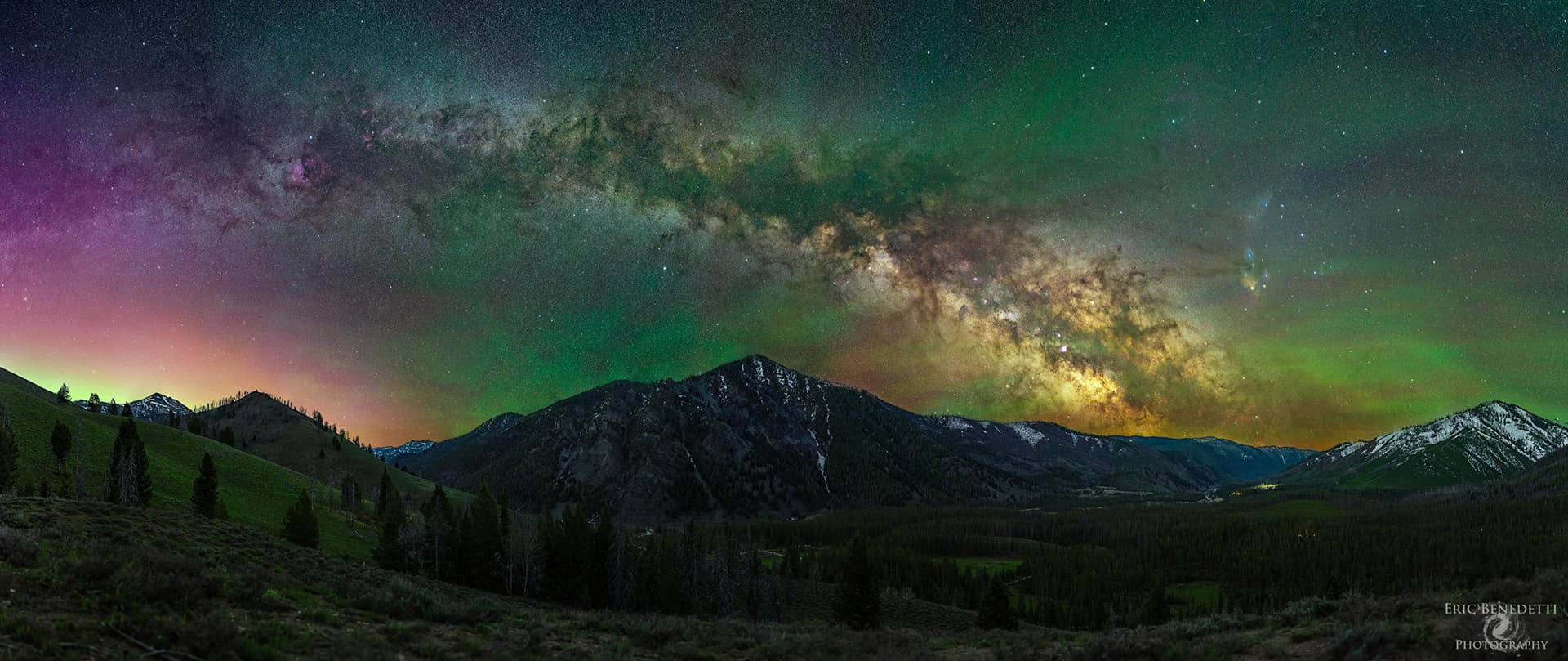
“Land of the Yankee Fork” – Eric Benedetti
- Idaho, USA
This is a shot from a hillside overlooking Yankee Fork Valley in central Idaho, which is lush and green from an incredible amount of water that melts from the heavy winter snow.
38 exposures total went into making it, altogether it took nearly 2 hours to capture all the images starting from the left (north). At first, I was a little upset because it appeared that there was a tremendous amount of light pollution along the northern horizon, but there are no towns in the area, nothing that could produce that kind of light pollution. It wasn’t until I had driven down into the valley later that night to take some more shots, that I realized it was something I had always wanted to see an image of, a legitimate bucket list item, the Aurora Borealis! That night, a spectacular Northern Lights show was on display. I have never been so happy to be out imaging the night sky in my entire life, something I will never forget. The purples/pinks/reds/greens from the lights combined with an absolutely ridiculous amount of green and red airglow helped produce the most colorful image I’ve ever put together.
This is a personal reminder; you never know what new and amazing things you’ll get to experience when you go out shooting at night; always take advantage of any time you can get under clear night skies. 38 exposures stitched together (no stacking), all shot back to back with my Nikon D800E and Sigma Art 50mm lens on a Sky-Watcher Star Adventurer. All exposures are 2 minutes at ISO 1600, sky shots at f2.8, foreground at f1.4.
“Star Eruption” – Diego ugalde

“Star Eruption” – Diego Ugalde
- Volcán de Fuego – Guatemala
I planned this shot in 2019, and my idea was to capture the Milky Way coming out of the volcanic cone of the “Volcán de Fuego” in Guatemala as if it were an eruption of stars.
I had to travel from Costa Rica to Guatemala to be able to do it. Once in Antigua Guatemala, we moved to the foot of the Acatenango Volcano, where we began our ascent by walking to the base camp at 3,800 m (around 12,500 ft.). From the base camp, the view of the Volcán de Fuego is spectacular, and I was in the right position to take the photo.
Once at the top, we were waiting for a clear night on no sleep. The Milky Way started to rise at 4, moving across the sky to the specific position I wanted. Then I just needed to wait for a lava eruption from the Volcán de Fuego. Waiting at 3,800 m at 4 in the morning is quite difficult; the cold is constant and the batteries of the cameras die fast. With the camera settings ready, the Volcán de Fuego started the show. I took my picture and the extra batteries died. I just had the time to take just a couple of shots, and luckily this one turned out to be right! Even if I had not succeeded, I still think it would have been an unforgettable experience, since the Volcán de Fuego spectacle is simply incredible.
“Heavenly throne” – Ryan Smith

“Heavenly Throne” – Ryan Smith
- Southwest USA
I was thrilled when I received a call from Canon who wanted to send me the EOS Ra to test out in the field. Intrigued at the offer, I knew I had to go somewhere great to put the Ra to the test. There’s nowhere better than the desert of the Southwest so off I went!
The EOS Ra is a mirrorless astrophotography camera that has a built-in infrared-cutting filter (positioned immediately in front of the CMOS imaging sensor), which permits approximately 4x as much transmission of hydrogen-alpha rays vs. standard digital cameras. This modification allows much higher transmission of deep red infrared rays emitted by nebulae, without requiring any other specialized optics or accessories.
I really enjoyed testing this out, shooting the dark skies of the Southwest, and I’m very excited to continue to see what Astro images I can take with this camera this year.
“Desert Tracks” – Melanie Fritz

“Desert Tracks” – Melanie Fritz
- Atacama Desert – Chile
The Atacama region is renowned for having one of the darkest skies in the world thanks to its low light pollution and zero humidity, which create the perfect conditions for observing all the details of the night skies.
This photograph represents the unique textures of the Atacama that have been shaped by the extreme dryness since it is one of the driest places on earth. This magical place is full of landscapes that make you feel like being on another planet, with its rock formations and colorful lagoon oasis in the middle of the desert.
This photograph is composed of 2 shots, one for the foreground and one for the sky.
“A Night at the Caves” – Sam Sciluna

“A Night at the Caves” – Sam Sciluna
- “Ta Marija” Cave – Malta
I wanted to capture the core of the Milky Way over the entrance to ‘Ta Marija’ cave for years. I tried it several times previously, but I was unable to capture an image I was happy with. Last July, I headed back with a friend of mine to try to get a better shot, and finally make this dream a reality.
The location is fairly remote, requiring a 45-minute hike across a huge boulder field. We got to the location about an hour before sunset, explored the area, and looked for all the possible compositions. We shot through sunset and blue hour, and then cooked some dinner as we waited for the Milky Way to be in the perfect spot. We spent several hours shooting the Milky Way that night, trying different compositions, and even some panos.
My favorite image was this composition, shot with a Samyang 14mm lens. The sky is a 4-minute tracked exposure at F4 and ISO 800, whilst the foreground is an 8-minute exposure at F2.8 and ISO 800 to reduce noise.
“Desert Nights” – Peter Zelinka
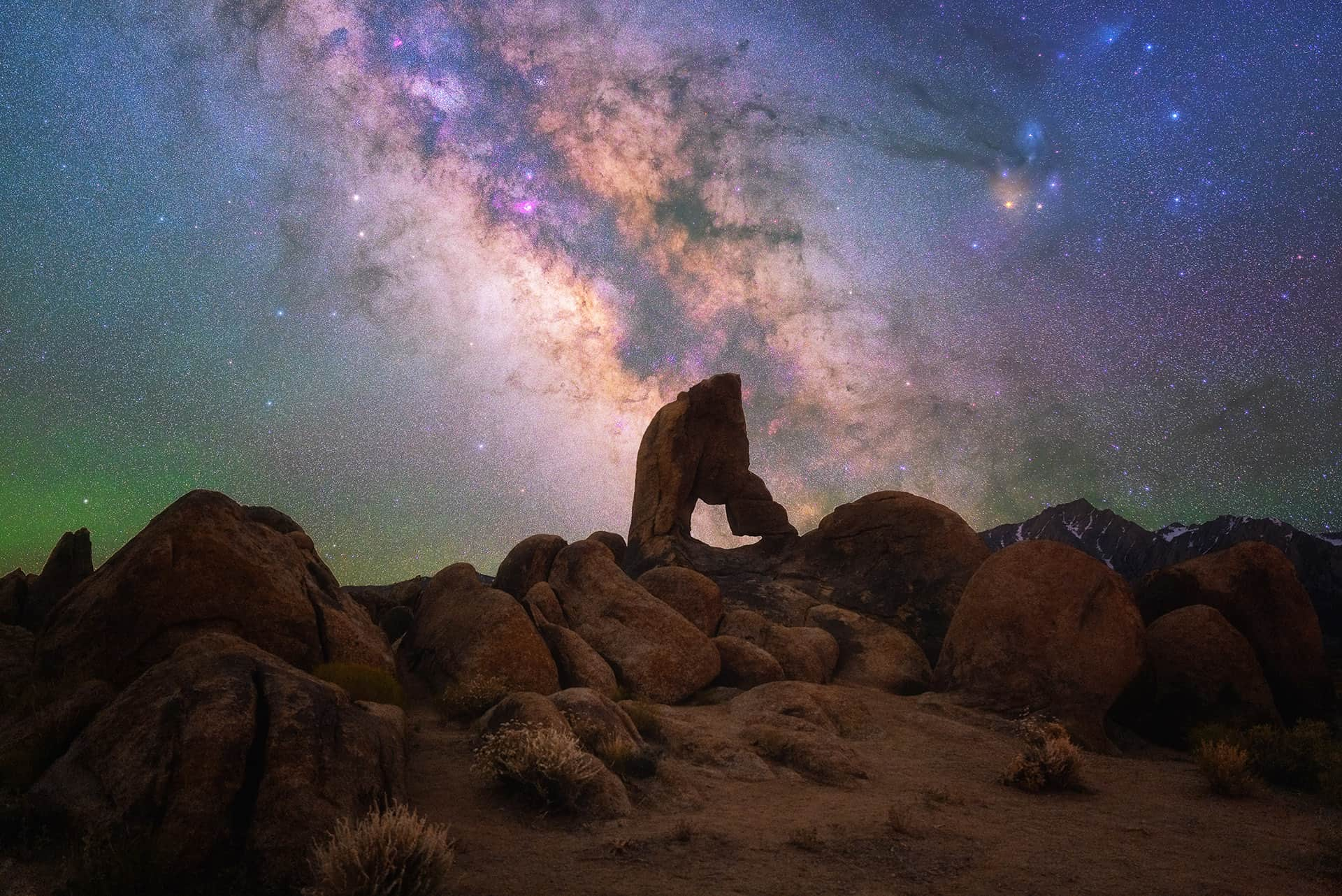
“Desert Nights” – Peter Zelinka
- Alabama Hills, California – USA
When I’m traveling through California, I always make sure to stop by the Alabama Hills. This is one of the most iconic locations in the western USA, with its incredible snow-capped Sierra Mountains, unique rock formations, and dusty roads.
In June 2019, I spent a few nights camping in the desert beneath the stars. Once the Milky Way was shining brightly overhead, I wandered through the brush and found this unique arch.
My first goal was to capture a clean, detailed foreground. Therefore, I used my Nikon D750 and 14-24mm lens with an f/4 aperture, ISO 800, and a 4-minute exposure. These settings allowed the camera to capture enough light for a clean image. Once I completed the foreground exposure, I set up my star tracker nearby. I used the same settings, but this time with the star tracker turned on. I now had sharp stars, but a blurry foreground. Once I got back to the computer, I was able to blend both exposures together for a beautiful final image.
“Good Night UTah” – Julio Castro
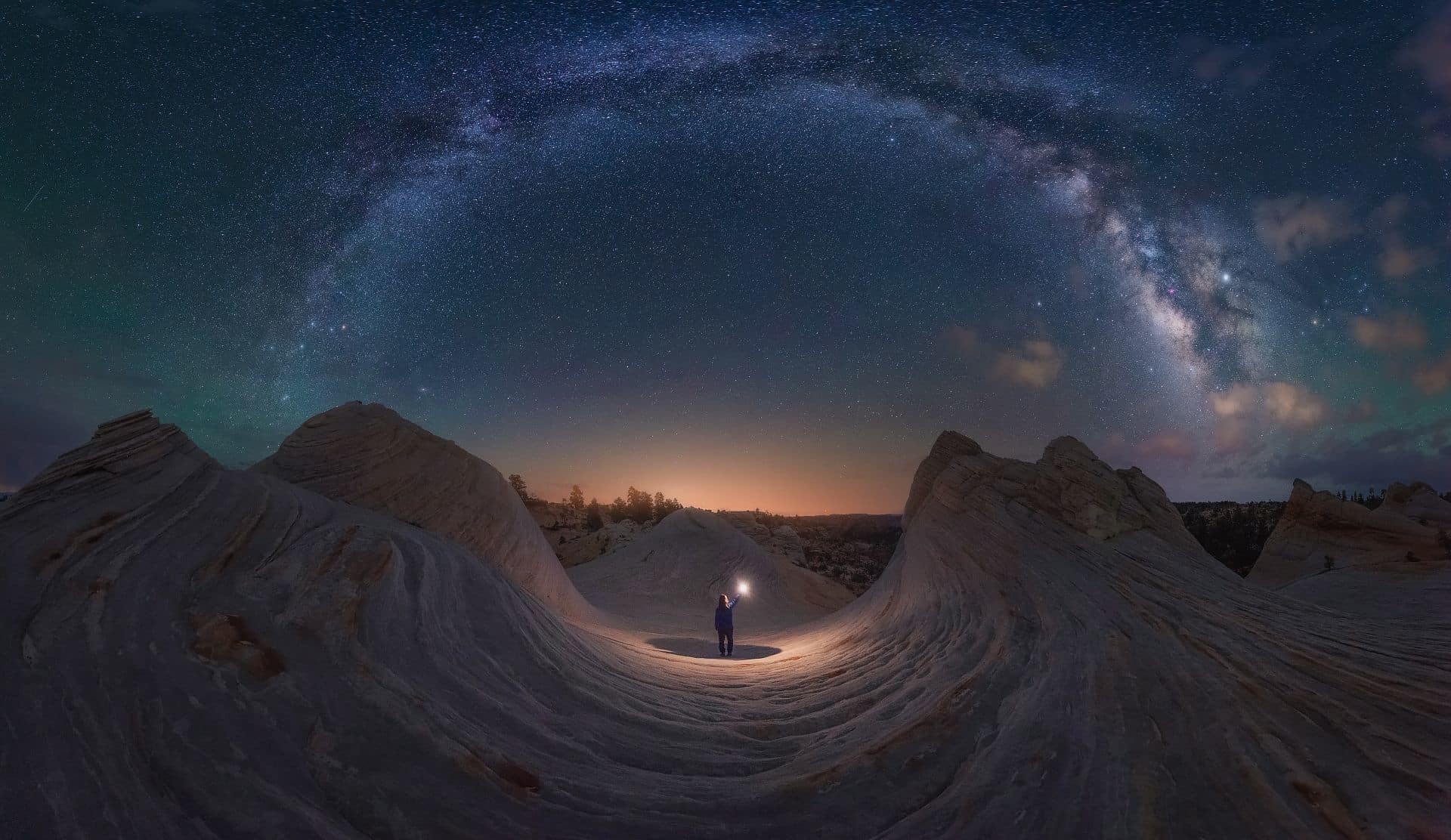
“Good Night Utah” – Julio Castro
- Kanab, Utah – USA
After visiting this location in 2017, it became my personal obsession to take a photo there, mainly because I couldn’t take any night shots since the place was very remote.
In May, I decided to go back and try to take the photo I had in mind. After a very cloudy night, just before dawn, the sky opened up, and a spectacular starry sky gave me the opportunity to take this picture with the arch of the Milky Way above the “wave” of rock that seems to surround the two hills, creating an almost perfect circle and allowing me to get the photo I had dreamed of.
I hope you found these images inspiring and that they spark your imagination to plan your future Milky Way shoots.
Don’t forget that planning is key in Milky Way photography, and the best way to prepare your shootings is by downloading our free Milky Way Calendars according to your location to know when the best days and hours are to capture the galaxy.
Thank you for sharing this article with other friends and colleagues who might find it inspiring.
…and just before you leave…you can receive more inspirational articles, photography guides, and more photo tips and resources by simply subscribing to our community. We would be happy to have you in this group of passionate and like-minded photographers!
Below is a gallery with all the images at their full size. Enjoy it!
Please do not download, copy or share any of the photos here without the author’s prior written permission. Consider the photos here to be protected by copyright. If anyone uses any of the photographs we will take the required legal actions.

